Islas Marías: A notorious prison island turned natural paradise
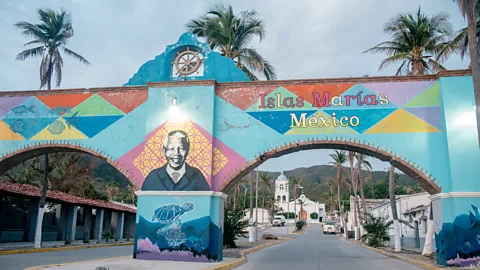 Getty Images
Getty ImagesIn 2019, Mexico's Islas Marías prison – the last island penal colony in the Americas – finally closed. Now a biosphere reserve, the once-feared archipelago is open to tourists on restricted, navy-organised tours.
I was at the ferry port in San Blas, a coastal town in western Mexico's Nayarit state, when two men wearing fatigues and carrying machine guns passed me in the queue. Next came a guard leading an Alsatian, which diligently sniffed my backpack. Along with a few hundred middle-aged Mexican tourists, I was about to board a weekend tour organised by the Mexican navy to María Madre, the largest island in the Islas Marías archipelago – once known as the "Alcatraz of Mexico".
Unbeknownst to me at the time, my trip came just before US President Trump ordered his government to reopen and expand Alcatraz, the infamous former prison on an island near San Francisco whose operations were formally shuttered in 1963. Alcatraz has since become a major tourist attraction where visitors can experience the historic cellhouse as it once was, and Mexico's own notorious former prison similarly allows tourists to peruse its cells. Unlike Alcatraz, however, the Mexican island has been transformed into a remarkable place of conservation.
Located about 130km from the Mexican mainland, María Madre spans around 145 sq km and is part of a four-island nature reserve that's now managed by Mexico's navy. Since 2022, tourists have been allowed to visit via four-hour ferry trips from San Blas and Mazatlán city, exploring designated areas under supervision.
For many Mexicans, Islas Marías needs no introduction. The prison, founded in 1905, housed mass murderers and was the setting for the prolific Mexican director Emilio Fernández's 1951 film Las Islas Marías.
"They used to have the big shots here, the big criminals," said fellow passenger Francisco Espinosa, who told me was drawn to the tour by the film, which shows the island's beaches and salt flats that prisoners worked on. "It's like Alcatraz. Everybody knew about this prison."
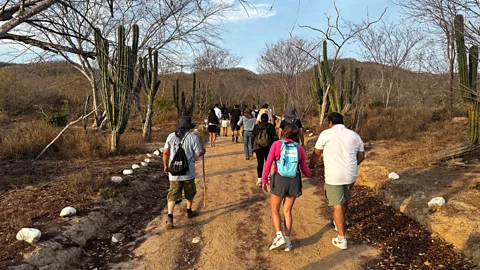 Jamie Fullerton
Jamie FullertonThe island is prone to extreme wind and a military base operates there, so we were compelled to watch a safety video about what to do if the island suffers a tsunami or gas attack (for the latter, cover your nose and run). After the video, I glimpsed huge sea turtles breaching the ocean surface from the ferry window.
The natural spectacle continued after we walked over María Madre's concrete jetty and dropped our bags in the hotel complex created for the new visitors. Herds of wild goats scattered from the pathways between restaurant buffet buildings and little gift shops as the incoming humans interrupted their wandering. The sound of hooves on concrete dovetailed with the burble of water crashing from a large waterfall-style water feature, plus loud squawks emanating from trees overhead.
One of our guides explained that the squawks signalled mating season for the green Tres Marías amazon parrots that are endemic to the island. Prisoners used to get family members to smuggle these prized parrots to the mainland, to sell. The boa population also took a hit as prisoners caught snakes to make belts from their skin.
I was assigned an airy, white-painted villa, which guides said used to house prisoners. They explained that some prisoners were allowed to have their families live with them on the island and could roam relatively freely. However, life wasn't open and breezy for all, with many forced to work in sweltering heat on salt flats or shrimp farms. In 2022 an ex-prisoner told the Los Angeles Times that she remembered five bathrooms being shared by 500 female prisoners. "We lived in a chicken coop," she said.
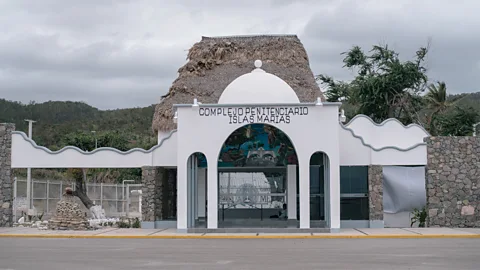 Getty Images
Getty ImagesBut in 2010, when the prison was still open, Unesco declared Islas Marias a biosphere reserve, noting the biological wealth found in the "dry forests of its landscape, in the mangroves, the succulent rosette scrubland, the reefs, coasts and pelagic environments it harbours". As well as the contraband parrots, the island is home to 18 other endemic species, including raccoons and rabbits. Mexico's National Commission of Natural Protected Areas (CONANP) is charged with protecting the delicate ecosystem, which developed in isolation for more than eight million years, while the navy-run tours take visitors through the abandoned prison buildings and educates them on the flora and fauna.
"This is tourism for excursions, to explore, to live with nature," said Mexico's then-president Lopez Obrador in 2022. "What was a hell is becoming a paradise."
Plan your trip
When to go: All-inclusive tours to Islas Marías operate year-round, from either San Blas or Mazatlán in Mexico's Nayarit state. Ferries leave on Fridays and return on Sundays.
How to book: Book a tour, including accommodation, excursions, ferry rides and meals, from Visitaislasmarias.com. Tours cost from around 10,000 pesos (£390) for a one-person trip.
What to bring: There are no ATMs on the islands, so bring cash for snacks, alcoholic drinks, souvenirs, optional bicycle hire and tips. Take a hat and sun cream for outdoor excursions and consider anti-sickness pills for the four-hour ferry ride.
Still, most tourists come for the history, not the animals. I joined a group hike where our guide pointed out a rusty metal structure near a cliff edge. It looked like a sentry box but was in fact a torture cabinet for errant prisoners, positioned to become hellishly heated by the morning Sun. Tourists took turns climbing inside and pulling its squeaky door shut.
After a buffet meal soundtracked by piped saxophone renditions of Elton John songs, a bus took us over dusty roads to the former maximum-security prison complex. As we approached the vast grey buildings, past fencing topped with rolls of barbed wire, Macarena blasted from the bus speakers.
In 2006, after the Mexican government declared war against the country's drug cartels, the prison island changed from a relatively "open" prison to a more standard penitentiary. In 2011, a maximum-security section opened with a design based on US prisons: shiny steel tables, chairs and toilets, clanking metal doors and small cells with bunk beds. Fellow tourists thrust their arms between metal bars, posing for photos. Our guide said that there was a riot here in 2013 due to prisoners being riled about rations, and the section shuttered soon afterwards. Now wild goats canter between the unmanned watch towers.
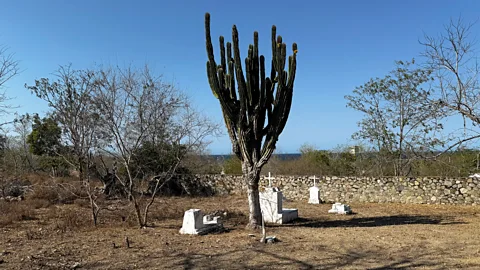 Jamie Fullerton
Jamie FullertonBut before the island housed a high-security prison, it served as a place of exile for petty criminals and "undesirables". President Álvaro Obregón began shipping political opponents here in 1910, and in the 1920s, it housed Catholic supporters rounded up in the Cristero War (1926-29).
One of its most notable political prisoners was writer and activist José Revueltas, who was sent to the island twice in the 1930s. He was a member of the Mexican Communist Party declared illegal by the government and was convicted after attending a union strike. A mural of the bespectacled, long-goateed Revueltas adorns the wall of the hotel check-in building.
Later, the bus took us to a Sun-blasted graveyard flanked by huge cacti, where we paused by a white cross. This was the tomb of José Ortiz Muñoz – known as "El Sapo aka The Toad" – an alleged former government assassin who was brought to the island in the 1960s after reportedly killing hundreds of people. He was murdered by fellow prisoners wielding machetes. A guide pulled out her phone to play El Sapo, a jaunty song by the singer Chalino Sánchez. An iguana skittered from the neighbouring tomb's surface, its tail disappearing under tiles.
Reports from former Islas Marías residents suggest that less well-known killings also took place on the islands. In 2004, an island chaplain named Francisco Ornelas wrote: "It is rumoured – and rumours are a profession here – that people who were disappeared are buried on the other three islands, which are now deserted but for the visits of illegal fishermen and drug traffickers."
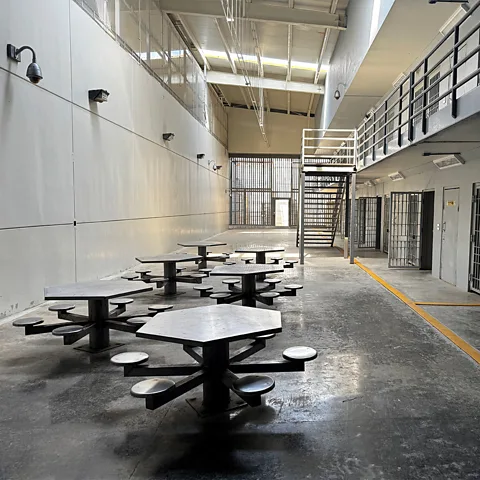 Jamie Fullerton
Jamie FullertonAccess to the waters around Islas Marías was restricted after María Madre became a penal colony in 1905. Fishing was further limited in 2000 when the area was declared a bioreserve by Mexican authorities, ahead of Unesco's declaration in 2010. In 2021, fishing restrictions were tightened again, with all commercial fishing without a permit from the navy banned in the area.
However, conservationists say that illegal fishing hasn't been effectively cracked down on by authorities. Octavio Aburto-Oropeza, a marine conservationist and professor at Scripps Institute of Oceanography, echoed this when I spoke to him after the tour. "I know companies that offer not only recreational fishing [around Islas Marías], also spear fishing," he said.
Aburto-Oropeza has dived the waters around Islas Marías on two separate trips, and says that while illegal fishing remains a concern, the reefs and wider marine ecosystem are in good shape, largely due to the archipelago's isolation and low visitor numbers.
He believes that the navy and CONANP should do more to tackle illegal fishing and set tangible goals for reef and species restoration, but that responsible tourism could also help. "You can create a vision of tourism on the reefs with a certain capacity," he said. "Touristic activities, especially diving, could help enforce conservation projects."
I hope to return – perhaps to dive, or explore more land sites. A guide showed me photos of buildings that are currently off-limits, including derelict rooms filled with quirky octopus sculptures made by prisoners. In time these buildings might be certified safe to visit, she said.
On the ferry back to San Blas, I chatted to fellow passengers about parrots, torture boxes and the surreal experience of stepping into "Mexico's Alcatraz". Not one said the prison should re-open.
--
If you liked this story, sign up for The Essential List newsletter – a handpicked selection of features, videos and can't-miss news, delivered to your inbox twice a week.
